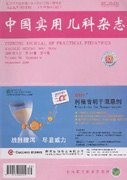|
Clinical diagnosis and treatment analysis of congenital pulmonary arteriovenous malformation in children
ZHANG Shu-lan,TIAN Man,BAO Yu-ling,et al
2020, 35(9):
717-721.
DOI: 10.19538/j.ek2020090611
Objective To explore the clinical features of congenital pulmonary arteriovenous malformations in children,and evaluate the role of CT angiography(CTA) and digital subtraction angiography(DSA) in the diagnosis. Methods Retrospective analysis method was used to analyze the clinical features,laboratory tests,imaging data and treatment outcomes of seven cases of congenital pulmonary arteriovenous malformation admitted to Children’s Hospital of Nanjing Medical University. Results (1)Four cases were pulmonary arteriovenous fistula with the main clinical symptom of cyanosis and clubbed fingers,and were shown to be pulmonary arteriovenous malformations by CT angiography(CTA). One case received surgical resection of the right lower lung. Two cases received thoracoscopic ligation surgery for the involved pulmonary arteriovenous fistula. One case underwent occluded embolization surgery for the right lower arteriovenous fistula under DSA. The cyanosis and clubbed fingers were significantly improved after 1-5 years’ clinical follow-up in three cases. One case still stayed in the hospital for treatment. (2)Three cases were bronchial artery-pulmonary arterial fistula with clinical manifestation of hemoptysis. According to the CT angiography(CTA)imaging of two cases,one case was thickened and tortuous right bronchial artery,and the other case had no abnormal bronchial artery. DSA surgery was performed in all three patients. Abnormal bronchial artery branch development and shunt were observed during the surgery. Two cases received occluded embolization treatment for the bronchial artery. One case had hemoptysis again two months after the occluded embolization treatment,and was occluded again. The 3-year follow-up showed no hemoptysis after that. One case was clinically observed due to small shunt and was followed up for about 15 months,which showed nohemoptysis. Conclusion Children with unexplained hemoptysis,cyanosis and clubbed fingers should be considered as with congenital pulmonary arteriovenous malformations;CTA or digital subtraction angiography is helpful to make a definite diagnosis. Compared with CTA,DSA shows the involved blood vessels and their movement more directly,and helps to judge the range and complexity of the involved vessels.
|

